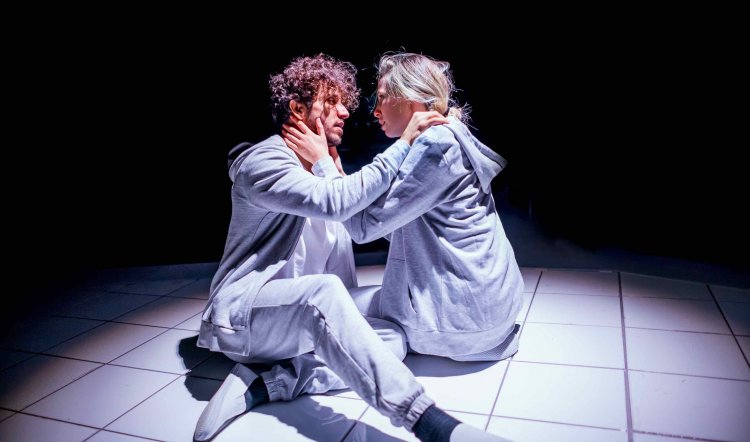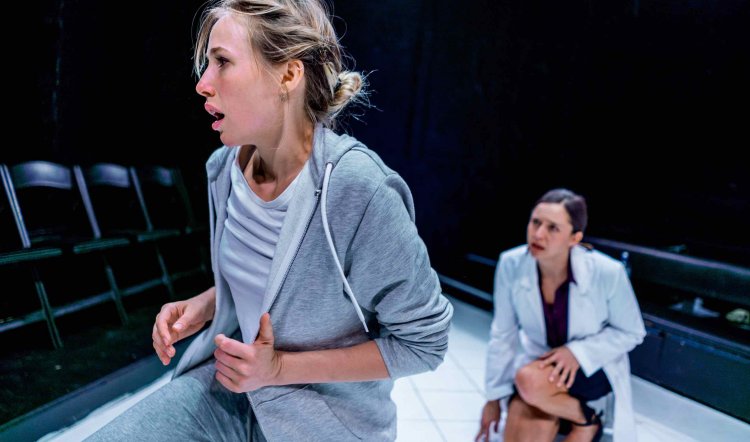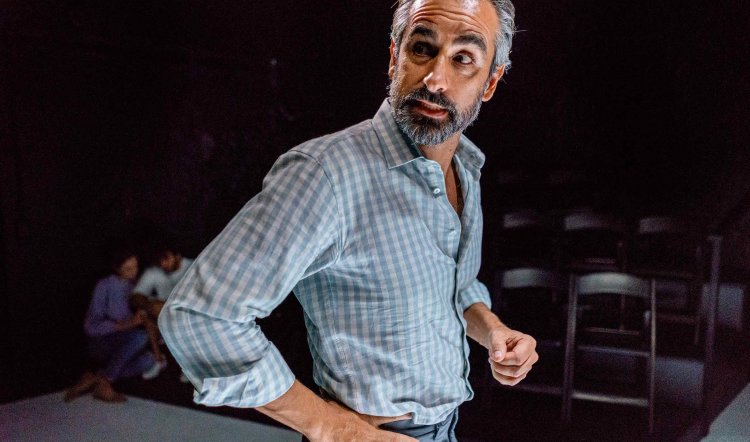
THE EFFECT
THE EFFECT, Red Line at the Old Fitz, 18 April-19 May 2018. Photography by John Marmaras: above - Firass Dirani and Emilie Cocquerel; below - Cocquerel and Emma Jackson; below again - Jonny Nasser
Lucy Prebble had a hit with her first play, Enron in 2009 and The Effect is her second. It was produced in Australia in 2014 in separate productions by Melbourne Theatre Company (starrily featuring William McInnes and Sigrid Thornton as the scientist and psychiatrist) and in Brisbane and Sydney in a co-production between Queensland and Sydney Theatre Companies – with Angie Milliken as the marquee name and psychiatrist.
That such a problematic play warranted the attention and money lavished on it then by three (!) state companies was neatly summed up at the time by Andrew Furhmann’s review in The Daily Review which described it as, “like a TED talk on brain science jammed into a flimsy relationship drama about the difference between love and lust”. Harsh, but I wouldn’t argue. Another way of looking at it: a favourite fruit for the big companies to pluck in a YBP (Young Brit Playwright) and a fashionable topic: brain science, as well as the perennial – love.
Nevertheless, in the four years since the play’s (mixed) Australian reception, an impossible hole has been blown in its central premise of two young guinea pigs (Emilie Cocquerel and Firass Dirani) fronting up for a drug trial and blowing a hole in it by falling love. And the bigger hole – into which the play falls – is that anyone with access to news has read that scientists have discovered placebos are often as effective in clinical trials as the actual drug being tested. Whoops.
In director Andrew Henry’s stylish production he plays it straight, neither localising nor updating in any perceptible way and relying on our interest in the ideas of how brains work – emotionally, socially, manipulatively and manipulated. And how depression is perceived and dealt with over time, or not.

Emma Jackson is the psychiatrist, doling out tablets to the two volunteers and behaving like a cranky old school head mistress when they show signs of mucking up. Johnny Nasser is the other clinician, once the psychiatrist’s lover and – as it soon becomes apparent – still the major player in her heart and mind.
Questions arise for the audience: which of the volunteers is on the placebo or the trial drug? When will the hanky-panky begin? And, how will any experiment into brain function work when the likely intervention of human emotion occurs, as it almost certainly will? And how do you account for that in your findings?
The action is played out on an elaborate set-with-integrated lighting (set and costumes by Brodie Simpson, lighting by Alexander Berlage). It’s the second time recently that a cross-shaped traverse has been made of the Old Fitz space. It offers physical variety and nuance for the actors but is not as effectively realised as it was for Iain Sinclair’s A View From the Bridge. Perhaps because the low-raised diamond-shaped platform-stage – all white tiles and flashily underlit – becomes the star of its own show and detracts fatally from the humans on it.
The actors do their best – and they’re all fine performers in their own right – but the flaws of logic in the play are even greater now than they were when it was first written – and the placebo effect is only one of them. All in all, it offers little beyond pop science and in its apparent concerns comes over as a double whammy of faux-fake. It’s also repetitive and feels interminable.

Writing for Stagenoise in 2014 in my absence overseas, Whitney Fitzsimmons summed up The Effect in a way that needs no elaboration: “...there are structural problems with the overall play. There is a point where the story extends past what should be its natural ending. It would be interesting to see a reduced 90 minute version performed without interval.”
True then, but four years have overtaken the play's relevance and it just doesn’t work. As well as the much-needed cut to 90 minutes, where the play now really starts is at the end when an overdose of the drug renders one of the guinea pigs “transiently amnesiac” – that’s when it suddenly comes to life. The End.



